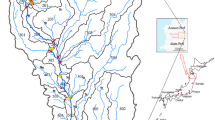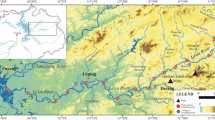Abstract
The physicochemical properties and heavy metal(loid) concentrations of the river water both fluctuate greatly along the river affected by mining activities, and the transportation of heavy metal(loid)s is therefore more complicated than unpolluted river. Dissolved and particulate heavy metal(loid)s in a river polluted by mining activities were measured to study their temporal-spatial variation and partitioning. The concentrations of dissolved arsenic (As), cadmium (Cd), manganese (Mn), nickel (Ni), lead (Pb), and zinc (Zn) were considerably high at the sites near the mine area. Notably, dissolved As at most sites were higher than the Chinese quality criterion of class II for surface water indicating high environmental risk. Mn and Pb at most sites and Ni at a part of the sites mainly existed in the particulate phase. For other heavy metal(loid)s, i.e., As, Cd, chromium (Cr), and Zn, the particulate phase was extremely high at the sites near the mine area and responsible for heavy metal(loid) transport. Significant correlations between particulate heavy metal(loid)s and temperature and electrical conductivity (EC) were found. However, the partitioning of heavy metal(loid)s did not significantly relate to the river water properties, due to most heavy metal(loid)s in suspended particulate matter (SPM) are stable and affected less by water properties. Except for Cr and Ni, other heavy metal(loid)s showed high concentrations in sediments, and considerable Cd, Mn, and Zn existed in exchangeable and carbonate fraction indicating high environmental risk. The environmental assessment of SPM showed that Cd, Zn, and As, as the main pollutants in SPM, all reached extremely polluted level at the sites near the mine area, and the environmental risk of heavy metal(loid)s in SPM was higher during dry season than that during wet season. The results can contribute to understanding the partitioning and transportation of heavy metal(loid)s in the river affected by mining activities.





Similar content being viewed by others
References
Bhattacharyya K, Gupta S (2008) Adsorption of a few heavy metals on natural and modified kaolinite and montmorillonite: a review. Adv Colloid Interf 140(2):114–131. https://doi.org/10.1016/j.cis.2007.12.008
Bourg ACM, Kedziorek MAM, Crouzet C (2000) Seasonal cycles of dissolved Cd, Mn and Zn in river water caused by variations in pH induced by biological activity. Aquat Geochem 6:461–471
Bradl HB (2004) Adsorption of heavy metal ions on soils and soils constituents. J Colloid Interface Sci 277(1):1–18. https://doi.org/10.1016/j.jcis.2004.04.005
Cai M, Liang T, Wu D (2005) Geological characteristics and ore-forming time of the Kangma deposit in the Dachang tin-polymetallic ore field, Guangxi. (in Chinese). Acta Geol Sin 79:262–268
Chao TT, Theobald PK (1976) The significance of secondary iron and manganese oxides in geochemical exploration. Econ Geol 71(8):1560–1569. https://doi.org/10.2113/gsecongeo.71.8.1560
Chen X, Xia X, Zhao Y, Zhang P (2010) Heavy metal concentrations in roadside soils and correlation with urban traffic in Beijing, China. J Hazard Mater 181(1-3):640–646. https://doi.org/10.1016/j.jhazmat.2010.05.060
CNEMC (China National Environmental Monitoring Certer) (1990) The Backgrounds of Soil Environment in China. China Environment Science Press, Beijing
Concas A, Ardau C, Cristini A, Zuddas P, Cao G (2006) Mobility of heavy metals from tailings to stream waters in a mining activity contaminated site. Chemosphere 63:244–253
Feng C, Guo X, Yin S, Tian C, Li Y, Shen Z (2017) Heavy metal partitioning of suspended particulate matter–water and sediment–water in the Yangtze Estuary. Chemosphere 185:717–725. https://doi.org/10.1016/j.chemosphere.2017.07.075
Gillman G, Sumpter E (1986) Modification to the compulsive exchange method for measuring exchange characteristics of soils. Aust J Soil Res 24(1):61–66
Hart BT (1982) Uptake of trace metals by sediments and suspended particulates: a review. Hydrobiologia 91:299–313
Helali MA, Oueslati W, Zaaboub N, Added A, Aleya L (2016a) Chemical speciation of Fe, Mn, Pb, Zn, Cd, Cu, Co, Ni and Cr in the suspended particulate matter off the Mejerda River Delta (Gulf of Tunis, Tunisia). J Afr Earth Sci 118:35–44
Helali MA, Zaaboub N, Oueslati W, Added A, Aleya L (2016b) Suspended particulate matter fluxes along with their associated metals, organic matter and carbonates in a coastal Mediterranean area affected by mining activities. Mar Pollut Bull 104:171–181
Hierro A, Olías M, Cánovas CR, Martín JE, Bolivar JP (2014) Trace metal partitioning over a tidal cycle in an estuary affected by acid mine drainage (Tinto estuary, SW Spain). Sci Total Environ 497-498:18–28. https://doi.org/10.1016/j.scitotenv.2014.07.070
Ji H, Ding H, Tang L, Li C, Gao Y, Briki M (2016) Chemical composition and transportation characteristic of trace metals in suspended particulate matter collected upstream of a metropolitan drinking water source, Beijing. J Geochem Explor 169:123–136. https://doi.org/10.1016/j.gexplo.2016.07.018
Karbassi AR, Fakhraee M, Heidari M, Vaezi AR, Samani ARV (2015) Dissolved and particulate trace metal geochemistry during mixing of Karganrud River with Caspian Sea water. Arab J Geosci 8:2143–2157
Lepš J, Šmilauer P (2003) Multivariate analysis of ecological data using CANOCO. Bulletin of the Ecological Society of America. Cambridge University Press, New York. https://doi.org/10.1017/CBO9780511615146
Liu P, Zhao H, Wang L, Liu Z, Wei J, Wang Y, Jiang L, Dong L, Zhang Y (2011) Analysis of heavy metal sources for vegetable soils from Shandong Province, China. Agric Sci China 10:109–119
Liu G, Tao L, Liu X, Hou J, Wang A, Li R (2013) Heavy metal speciation and pollution of agricultural soils along Jishui River in non-ferrous metal mine area in Jiangxi Province, China. J Geochem Explor 132:156–163. https://doi.org/10.1016/j.gexplo.2013.06.017
Liu G, Yu Y, Hou J, Xue W, Liu X, Liu Y, Wang W, Alsaedi A, Hayat T, Liu Z (2014) An ecological risk assessment of heavy metal pollution of the agricultural ecosystem near a lead-acid battery factory. Ecol Indic 47:210–218. https://doi.org/10.1016/j.ecolind.2014.04.040
Liu G, Wang J, Zhang E, Hou J, Liu X (2016) Heavy metal speciation and risk assessment in dry land and paddy soils near mining areas at southern China. Environ Sci Pollut Res 23(9):8709–8720. https://doi.org/10.1007/s11356-016-6114-6
Loisel H, Mangin A, Vantrepotte V, Dessailly D, Ngoc Dinh D, Garnesson P, Ouillon S, Lefebvre JP, Mériaux X, Minh Phan T (2014) Variability of suspended particulate matter concentration in coastal waters under the Mekong's influence from ocean color (MERIS) remote sensing over the last decade. Remote Sens Environ 150:218–230
Lu Y, Allen HE (2001) Partitioning of copper onto suspended particulate matter in river waters. Sci Total Environ 277(1-3):119–132. https://doi.org/10.1016/S0048-9697(00)00868-8
Macklin MG, Brewer PA, Balteanu D, Coulthard TJ, Driga B, Howard AJ, Zaharia S (2003) The long term fate and environmental significance of contaminant metals released by the January and March 2000 mining tailings dam failures in Maramureş County, upper Tisa Basin, Romania. Appl Geochem 18:241–257
Minh LQ, Tuong TP, van Mensvoort MEF, Bouma J (1997) Contamination of surface water as affected by land use in acid sulfate soils in the Mekong River Delta, Vietnam. Agric Ecosyst Environ 61(1):19–27. https://doi.org/10.1016/S0167-8809(96)01084-5
Muller G (1969) Index of geoaccumulation in sediments of the Rhine River. GeoJournal 2:108–118
Norris R (1986) Mine waste pollution of the Molonglo River, New South Wales and the Australian Capital Territory: effectiveness of remedial works at Captains Flat mining area. Mar Freshw Res 37(2):147–157. https://doi.org/10.1071/MF9860147
Rauret G, López-Sánchez JF, Sahuquillo A, Rubio R, Davidson C, Ure A, Quevauviller P (1999) Improvement of the BCR three step sequential extraction procedure prior to the certification of new sediment and soil reference materials. J Environ Monitor 1(1):57–61
Rinklebe J, Shaheen SM (2017) Geochemical distribution of Co, Cu, Ni, and Zn in soil profiles of Fluvisols, Luvisols, Gleysols, and Calcisols originating from Germany and Egypt. Geoderma 307:122–138. https://doi.org/10.1016/j.geoderma.2017.08.005
Rodríguez L, Ruiz E, Alonso-Azcárate J, Rincón J (2009) Heavy metal distribution and chemical speciation in tailings and soils around a Pb-Zn mine in Spain. J Environ Manag 90(2):1106–1116. https://doi.org/10.1016/j.jenvman.2008.04.007
Strady E, Dinh QT, Nemery J, Nguyen TN, Guedron S, Nguyen NS, Denis H, Nguyen PD (2017) Spatial variation and risk assessment of trace metals in water and sediment of the Mekong Delta. Chemosphere 179:367–378. https://doi.org/10.1016/j.chemosphere.2017.03.105
Turner A, Millward GE (1994) Partitioning of trace metals in a macrotidal estuary. Implications for contaminant transport models. Estuar Coast Shelf Sci 39(1):45–58. https://doi.org/10.1006/ecss.1994.1048
Wang Y, Liu RH, Zhang YQ, Cui XQ, Tang AK, Zhang LJ (2016) Transport of heavy metals in the Huanghe River estuary, China. Environ Earth Sci 75(4):288. https://doi.org/10.1007/s12665-015-4908-3
Yang Z, Xia X, Wang Y, Ji J, Wang D, Hou Q, Yu T (2014) Dissolved and particulate partitioning of trace elements and their spatial–temporal distribution in the Changjiang River. J Geochem Explor 145:114–123. https://doi.org/10.1016/j.gexplo.2014.05.013
Yao Q, Wang X, Jian H, Chen H, Yu Z (2016) Behavior of suspended particles in the Changjiang Estuary: size distribution and trace metal contamination. Mar Pollut Bull 103(1-2):159–167. https://doi.org/10.1016/j.marpolbul.2015.12.026
Zhang YY, Zhang ER, Zhang J (2008) Modeling on adsorption–desorption of trace metals to suspended particle matter in the Changjiang Estuary. Environ Geol 53(8):1751–1766. https://doi.org/10.1007/s00254-007-0781-z
Zhang H, Luo Y, Makino T, Wu L, Nanzyo M (2013) The heavy metal partition in size-fractions of the fine particles in agricultural soils contaminated by waste water and smelter dust. J Hazard Mater 248–249:303–312
Zheng T, Yang J, Huang P, Tang C, Wan J (2017) Comparison of trace element pollution, sequential extraction, and risk level in different depths of tailings with different accumulation age from a rare earth mine in Jiangxi Province, China. J Soils Sediments. https://doi.org/10.1007/s11368-017-1853-7
Funding
This work was financially supported by the National Basic Research Program of China (2013CB430405).
Author information
Authors and Affiliations
Corresponding author
Additional information
Responsible editor: Stuart Simpson
Electronic supplementary material
ESM 1
(DOCX 36 kb)
Rights and permissions
About this article
Cite this article
Wang, J., Liu, G., Wu, H. et al. Temporal-spatial variation and partitioning of dissolved and particulate heavy metal(loid)s in a river affected by mining activities in Southern China. Environ Sci Pollut Res 25, 9828–9839 (2018). https://doi.org/10.1007/s11356-018-1322-x
Received:
Accepted:
Published:
Issue Date:
DOI: https://doi.org/10.1007/s11356-018-1322-x




